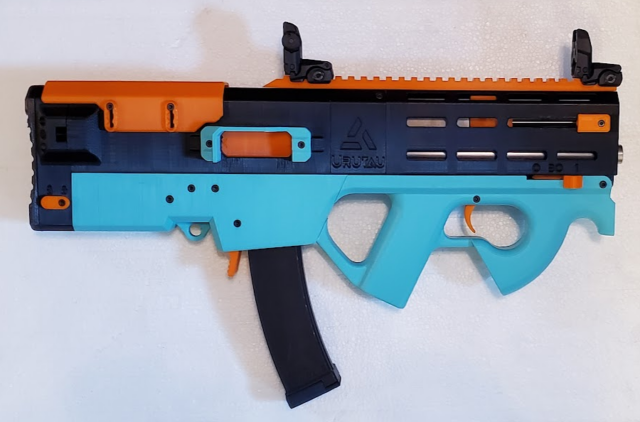
Interest in 3D-Printed Firearms Rising Among Islamist Militants
Publication: Terrorism Monitor Volume: 23 Issue: 1
By:

Executive Summary:
- Traditionally, Islamist militants have not been quick to adopt the newest drone and 3D printing technology, but the popularization of 3D-printed firearms (3DPFs) on Islamic State platforms suggests that that is changing.
- If 3DPFs become more widespread, malicious actors will be able to more easily conduct attacks in countries with strict firearms regulations, such as those in Europe.
In August, a pro-Islamic State (IS) supporter posted design manuals for the “Urutau,” a 3D-printed 9mm, semi-automatic rifle, on a popular IS messaging platform (BBC Monitoring, August 6, 2024). Inspired by the “FGC-9,” one of the most popular 3D-printed firearms (3DPFs) among criminal and terrorist cells, the Urutau is a purely do-it-yourself (DIY) firearm, which requires no regulated firearm parts (X/@JosephTheParrot, July 27, 2024). Manuals for the FGC-9, homemade ammunition, and barrels were also posted. The posts received positive responses from pro-IS users on the platform (BBC Monitoring, August 6, 2024).
3DPFs have been discussed briefly in pro-IS chatrooms before. The re-emergence of discussions around 3DPFs among pro-IS supporters highlights an interest in this technology. As a result, lone IS actors or cells could potentially adopt and employ this technology in attacks, increasing the threat in societies with otherwise strict arms control laws.
Rising Interest in 3DPF Among Islamist Extremists
The use of 3DPFs has increased drastically since 2019, particularly in Europe, North America, and Australia (BBC, November 9, 2022; The Age, November 4, 2022; CBS News, February 2, 2023). While they have been used primarily by criminal networks, several cases involving 3DPFs have been linked to terrorism, particularly the far-right (Combatting Terrorism Center, June 2024). Islamist militants have been less inclined to adopt 3DPFs. A possible reason is that militant Islamist propaganda has promoted the use of traditional methods, such as explosives, conventional firearms, stabbings, and vehicle ramming over utilizing emerging technologies in weapon-making, such as 3DPFs.
The recent discussions on 3DPFs may highlight a change in Islamist militant trends and signal a possible willingness among Islamist militants to experiment with new technology. In January 2023, Abdiwahid Abdulkadir Mohamed from North London was charged for possession of 3DPF manuals, which were likely to be used in committing an attack (BBC, January 10, 2023; Daily Mail, January 19, 2023). In September 2023, Mohammad al-Bared, a PhD student from Coventry in the United Kingdom, was alleged to have 3D-printed a drone for IS (The Guardian, September 28, 2023).
On a strategic level, al-Shabaab in Somalia was reported to have been experimenting with 3D printing to develop explosives, drone parts, and other weapons. This would make al-Shabaab one of the first jihadist groups to have actively experimented with this technology (United Nations Security Council, July 22, 2024). As 3D-printing technology and its manufacture become cheaper and more accessible, Islamist militants’ interest may turn increasingly toward 3DPFs.
Advantages of 3DPFs for Terrorists
While it is possible to create lethal 3DPFs that rival conventional firearms, it takes a certain amount of skill, time, effort, and experimentation. However, for anyone determined to invest in the process, 3DPFs offer two main advantages.
First, 3DPFs provide an attractive option for malicious actors to manufacture weapons in countries with strict firearms regulations, such as those in Europe. Hybrid 3DPFs, such as the FGC-9 and the Urutau, are primarily 3D-printed and do not require any regulated parts. Moreover, they are supplemented with commercially available materials that can be bought at the local hardware store, such as springs or steel tubing for the barrel. The FGC-9 was, in fact, created to circumvent strict gun laws in Europe and to enable anyone to own a firearm. This is why several terrorist cells in the United Kingdom and Finland have attempted to use the FGC-9 in planned attacks (The Guardian, February 27, 2024; yle, July 20, 2023). The FGC-9 has, however, also been employed by pro-democracy forces in Myanmar, which made it the first 3DPF to be used in an active combat zone (see Terrorism Monitor, May 6, 2024).
Second, 3DPFs offer terrorists (and criminals) operational security and complete anonymity. Because one can theoretically manufacture the entire weapon at home, there is no need for any individual to engage in weapons trafficking or criminal networks, which would otherwise provide an avenue for interdiction. The 3D-printing community has also been experimenting with homemade ammunition, which is currently one of the few parts of hybrid 3DPFs that needs to be sourced commercially.
Conclusion
New designs for 3DPFs are being developed and released for download daily. Some designs are cleverly made to look like toys, such as Nerf guns. With a 3D printer that costs between $200–300, it is possible to manufacture a workable firearm at home. Apart from firearms, 3D printing has also been used to make other components, such as silencers and conversion devices, which can turn semi-automatic weapons into fully automatic firearms (Wall Street Journal, February 17, 2024). Other weapons, such as explosives and knives, have also been made using 3D printing.
This all makes the recent interest in 3DPFs among Islamist militants a trend that is noteworthy. While in the near term, this appears to just be chatter, 3D printing is a growing technology that is only going to become more lethal and easier to manufacture over time. It will only take one successful attack using a 3DPF to throw this technology into the limelight and for other aspiring Islamist militants to jump onto the bandwagon and adopt it. Meanwhile, several far-right extremists have taken the 2019 Halle attack, in which the attacker had used 3D-printed components in his firearm, as an example of using 3DPFs in their own plots. Thus, the security community will be forced to stay vigilant, take this threat seriously, and adopt necessary preventive measures to mitigate the threat.



